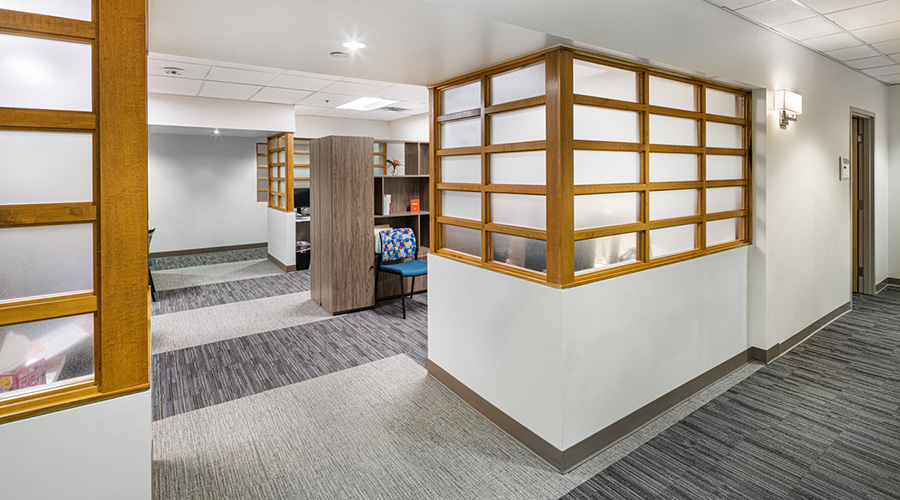Today’s healthcare facility managers are taking vital precautions to inhibit the spread of COVID-19 as workers head back to their corporate offices. From rethinking floor plans to rotating which workers are on site during any given week, clearing common areas of high-volume foot traffic to keeping employees informed about the most recent social distancing guidelines, healthcare facility managers are tasked with maintaining overall health and safety, and business productivity, while also enabling an engaging human experience.
If it sounds like a tall order, that’s because it is. Fortunately, there are now more technology tools and related data that can bring greater accuracy and efficiency to planning crucial safety strategies. By shining a clear light on how corporate office space is really being used, your team can use occupancy data to quickly identify COVID-19-related concerns as they arise—and solve for them in a few key ways—while giving employees the space they need to do their most critical work.
The value of occupancy planning data, through a pandemic lens
Many healthcare organizations are positioned to tap into invaluable occupancy data, having adopted a variety of high-tech and low-tech methods to monitor the spatial distance between employee workstations (density), number of employee remote working days (mobility), and/or number of desks available (occupancy) on any given day.
According to JLL’s annual Occupancy Benchmarking Report, 80 percent of healthcare organizations gather some form of utilization data, though new tools and capabilities emerge every day to create a clear picture of how space is used. Every data point collected can directly support both short-term safety measures, as well as long-term productivity and experience goals.
For example, according to our survey, only 63 percent of available workspace in the healthcare sector is fully utilized. This suggests that, with some shrewd reconfiguration, there may be more space available to spread out than previously thought possible.
Of course, determining the ideal density for an administrative space will look very different now than, say, 12-18 months down the line. Looking ahead, the same data sets may point to an opportunity to better use space, perhaps even by right sizing the real estate footprint, once the pandemic has run its course.
There is also a powerful new reason to use data to track and formalize mobility programs: some form of remote work for at least a portion of office workers is here to stay.
In the short term, social distancing mandates, including rotational staffing strategies, have simply made mobile workforces a non-negotiable. But recent shutdowns have helped many organizations understand the broader benefits of mobility programs, including cost efficiencies and more-focused employees who rely on the office for a workplace experience.
The opportunity is particularly significant for healthcare, given only 20% of our survey’s healthcare organizations reported having a formal mobility strategy. Furthermore, the occupancy planning tools can quantify the impact of increasing mobility trends on long-term real estate needs, including how space is configured to meet employee expectations.
As we manage re-entry, offices will likely need to support individuals who can’t effectively work from home or simply want to be back in the office. But workers also increasingly want to use the office to socialize and collaborate, marking a shift from station-based work to more communal spaces (once the threat of COVID-19 is behind us).
Three ways data-driven occupancy planning supports safety now
Effective utilization data can help your organization formulate a workplace plan that carries you through the pandemic and supports long-term strategies once the threat has passed.
There is no one way forward for organizations as they proceed with re-entry. There are, however, some very clear benefits to using occupancy planning data in healthcare facility planning. Consider:
1) Occupancy data and technology super-charges planning. How quickly and painlessly can you achieve new de-densification thresholds? Have you mapped out risk points across the workplace? What change management plans and communication needs need to be aggregated and rolled out? Working with reliable data can remove a lot of guesswork and help you focus on critical decisions, making planning both more efficient and effective.
2) Utilization data helps inform new workplace protocols that can align with company culture. How much space will be needed between workstations to meet social distancing guidelines? Which teams can rotate into the office, at which workspaces, to minimize contact while maximizing the collaborative benefits of in-person work? What service and technical support should you offer to improve the remote work experience? Understanding how people inhabit the workplace can directly inform thoughtful new policies.
3) Monitoring technology supports employee adoption and compliance. From seat reservations to attendance monitoring, an array of low- and high-tech tools are available to track social distancing activity. For example, real-time Wi-Fi login and security badge data, together with data from heat and motion sensors, can help make sure teams are working where and when they should–or not. Armed with this information, facilities teams can quickly discover when enhanced cleaning protocols may be in order, for example, or whether it may be appropriate to issue new educational material or adjust personnel schedules altogether.
Workplace insights when they matter most – aka, always
Whether you’re simply removing furniture to ensure workstations are at least 7.5 feet apart, or using data visualization tools to integrate floorplans, occupancy data can serve you well now and into the future.
No health system is immune from existing budget pressures, or new ones we can expect ahead. Every organization will benefit from more agile, resilient and innovative real estate and workplace strategies as we collectively proceed into the ‘next normal.’
Amidst uncertainty in so much else, occupancy planning tools can help facility leaders effectively scale resources up or down, as further closures arise due to the pandemic. And the actions that organizations take now to prepare for short-term disruptions will also help them be better equipped to sustain future crises, from other outbreaks to natural disasters and economic disruptions.
Now is a time of major upheaval and crisis, but it is also a chance to harness new capabilities. By bringing together the right mix of data, technology, and human ingenuity, healthcare facility leaders can create safe, flourishing, and right-sized workplaces–now, and through the rapidly changing world we share.
Richard Taylor is Division President of JLL Healthcare Solutions.

 Code Compliance Isn't Enough for Healthcare Resilience
Code Compliance Isn't Enough for Healthcare Resilience Ribbon Cutting Marks First Phase Completion for New Montefiore Einstein Facility
Ribbon Cutting Marks First Phase Completion for New Montefiore Einstein Facility Brooks Rehabilitation Launches 3 New Major Construction Projects
Brooks Rehabilitation Launches 3 New Major Construction Projects Joint Commission Standards: What Updates Matter Most?
Joint Commission Standards: What Updates Matter Most? Swinerton Completes Construction at Atlanta's Grady Hospital
Swinerton Completes Construction at Atlanta's Grady Hospital